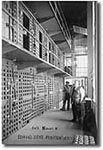The early history of the American West is popularly
associated with crime such as mining frauds, grand theft, horse and cattle rustling, and
stagecoach holdups. Living outside the boundaries of a central authority, farmers and
miners and merchants in what was to become Idaho Territory found themselves with
conditions that favored organized gangs and individual criminals.
One of the first responses of settlers was to form vigilante
groups, which banished lesser offenders and used lynchings to punish others. With signing
of the Organic Act of 1863 by President Abraham Lincoln, Idaho Territory received
recognition of its sovereignty and county jails at Idaho City and Lewiston were designated
as temporary territorial prisons.
Regional rivalries within Idaho caused some friction and
delay in selecting a site for a permanent territorial prison, as they had in locating the
territorial capital. When plans submitted by a Prison Commission were held up in the
Territorial Legislature, an enterprising Boise merchant jumped claim to the preferred site
by erecting a house on the property in a single night. Castigated by his customers and the
press, the merchant saved face by deeding his claim to the territorial government. In
1869, the Ada County Commissioners (with the consent of the U.S. Department of the
Interior) officially selected the site east of Boise for the prison. A ready supply of
high-grade quarry stone was a deciding factor in the location.
The General Land Office in Boise was asked to supervise
construction at the prison, which began officially on April 4, 1870. A ceremony for the
laying of the cornerstone was held on July 4, 1870 -- a decision the local newspaper noted
as ironic because it represented creation of a prison on Independence Day.
Convict labor was used for much of the construction that took
place over more than a decade at the site. The Dining Hall and a cell house (Two House)
were designed by prisoners.
With special value placed on agricultural labor by many
penitentiary wardens, such additions as wooden barns, stables, a slaughterhouse,
irrigation ditches, orchards, and poultry houses were built outside the prison walls.
Farmlands immediately adjacent to the original site were annexed and cultivated and the
prison was able to supply much of its own foodstuffs, as well as that for the state's
insane asylum at Nampa and for the Veteran's Home in Boise.
Over its century of operation, the penitentiary received more
than 13,000 convicts, of whom 215 were women. Spurred in part by conditions that sparked a
general riot in 1971 and an even more severe riot in 1973, the inmate population was moved
to a modern penitentiary south of Boise and the Old Idaho Penitentiary was closed on
December 3, 1973.
Courtesy Idaho State Historical
Society
 Administration building,
Old Idaho Penitentiary, ca. 1910. Prisoners quarried the stone used
to construct this building, the prison walls, and more than a dozen
other structures at the prison. ISHS 68-57.57.
Administration building,
Old Idaho Penitentiary, ca. 1910. Prisoners quarried the stone used
to construct this building, the prison walls, and more than a dozen
other structures at the prison. ISHS 68-57.57.  The "New Cellhouse" at the Old Idaho Penitentiary, ca. 1912.
ISHS 68-57.61.
The "New Cellhouse" at the Old Idaho Penitentiary, ca. 1912.
ISHS 68-57.61.